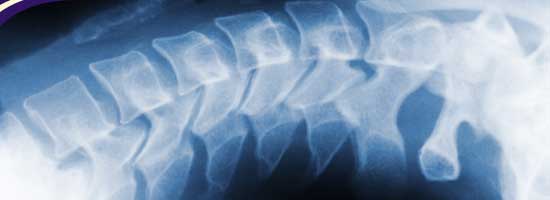Posted by Dr. Jonathan Walker on September 4, 2009 under Uncategorized | 
Remember your favorite part of elementary school? No, not recess….FIELD TRIPS! At Ocala Integrative Medicine, we’re still not too old to take field trips (not even Kathy)!
We recently visited Rosas Farms, located just north of Ocala in Sparr (yes, there really is a place called Sparr). You may have heard me talk about them before- this is the only farm in the entire state of Florida that raises 100% organic grass-fed beef. As a self-professed grass-fed beef afficianado, I was thrilled when Al and Erin Rosas invited my family and staff to come share a meal with them and take a tour of the farm.
As far as the food was concerned, if you’ve every had the creations of Chef Al Rosas (The Organic Chef), you won’t be disappointed. We were served a spread of tomato and mozzeralla salad, organic potato salad, some kind of ridiculously good won-ton type thing (I’m not enough of a foodie to know exactly what I ate), and the best part of the meal- a marinated hanging tenderloin. The Rosas’ daughter Lola, who is quite the budding young chef, made an orange meringue pie and chocolate torte for dessert.
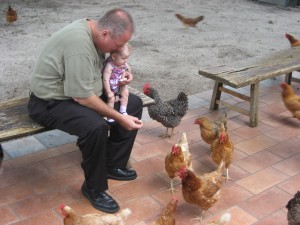
After lunch we were given the grand tour. First stop was the flock of free-range chickens who roam the farm. If you’ve ever heard the term free-range chicken used, it often means that the chickens are given a few minutes a day to mill around in a dirty, open air pen. As you can see in the picture of my daughter Ellie with her Grandpa, the Rosas Farms chickens are given run of the farm!
We even gave Kathy a flashback to her days growing up on the farm when she was put in charge of the chicken coop!
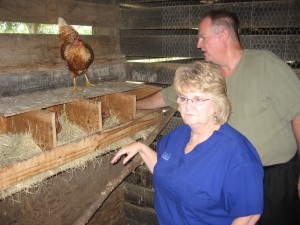
We also got to see the wild boars that are raised on the farm. These are the same hogs that run wild in central Florida, and on Rosas farms they are raised naturally for sausage, bacon, and all kind of other delicious goodies. 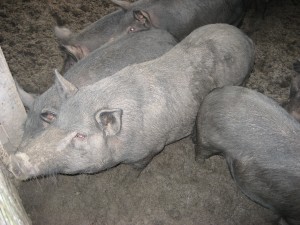
As much as I enjoyed all of the animals that the Rosas are raising, my favorite part of the field trip was getting to introduce Ellie to all of the animals that she’s seen in her books at home. At five months old she isn’t making any mooing or oink oink noises just yet, but she sure is cute! In order to fulfill my duties as a proud papa, I’m obligated to post pictures of my 100% free-range baby girl!

All I know is that if the Rosas decide to produce a line of organic baby food, they have their spokes-baby ready to go! Thanks to the Rosas family for their amazing hospitality to my family and my staff, and we can’t wait to visit again! If you’d like to make a trip of your own, check out Rosas Farms at www.rosasfarms.com!
Posted by Dr. Jonathan Walker on June 23, 2009 under Nutrition | 
From the New York Times Health Blog:
 As head of the Food and Drug Administration, Dr. David A. Kessler served two presidents and battled Congress and Big Tobacco. But the Harvard-educated pediatrician discovered he was helpless against the forces of a chocolate chip cookie.
As head of the Food and Drug Administration, Dr. David A. Kessler served two presidents and battled Congress and Big Tobacco. But the Harvard-educated pediatrician discovered he was helpless against the forces of a chocolate chip cookie.
In an experiment of one, Dr. Kessler tested his willpower by buying two gooey chocolate chip cookies that he didn’t plan to eat. At home, he found himself staring at the cookies, and even distracted by memories of the chocolate chunks and doughy peaks as he left the room. He left the house, and the cookies remained uneaten. Feeling triumphant, he stopped for coffee, saw cookies on the counter and gobbled one down.
“Why does that chocolate chip cookie have such power over me?” Dr. Kessler asked in an interview. “Is it the cookie, the representation of the cookie in my brain? I spent seven years trying to figure out the answer.”
The result of Dr. Kessler’s quest is a fascinating new book, “The End of Overeating: Taking Control of the Insatiable American Appetite” (Rodale).
During his time at the Food and Drug Administration, Dr. Kessler maintained a high profile, streamlining the agency, pushing for faster approval of drugs and overseeing the creation of the standardized nutrition label on food packaging. But Dr. Kessler is perhaps best known for his efforts to investigate and regulate the tobacco industry, and his accusation that cigarette makers intentionally manipulated nicotine content to make their products more addictive.
In “The End of Overeating,” Dr. Kessler finds some similarities in the food industry, which has combined and created foods in a way that taps into our brain circuitry and stimulates our desire for more.
When it comes to stimulating our brains, Dr. Kessler noted, individual ingredients aren’t particularly potent. But by combining fats, sugar and salt in innumerable ways, food makers have essentially tapped into the brain’s reward system, creating a feedback loop that stimulates our desire to eat and leaves us wanting more and more even when we’re full.
Dr. Kessler isn’t convinced that food makers fully understand the neuroscience of the forces they have unleashed, but food companies certainly understand human behavior, taste preferences and desire. In fact, he offers descriptions of how restaurants and food makers manipulate ingredients to reach the aptly named “bliss point.” Foods that contain too little or too much sugar, fat or salt are either bland or overwhelming. But food scientists work hard to reach the precise point at which we derive the greatest pleasure from fat, sugar and salt.
The result is that chain restaurants like Chili’s cook up “hyper-palatable food that requires little chewing and goes down easily,” he notes. And Dr. Kessler reports that the Snickers bar, for instance, is “extraordinarily well engineered.” As we chew it, the sugar dissolves, the fat melts and the caramel traps the peanuts so the entire combination of flavors is blissfully experienced in the mouth at the same time.
Foods rich in sugar and fat are relatively recent arrivals on the food landscape, Dr. Kessler noted. But today, foods are more than just a combination of ingredients. They are highly complex creations, loaded up with layer upon layer of stimulating tastes that result in a multisensory experience for the brain. Food companies “design food for irresistibility,” Dr. Kessler noted. “It’s been part of their business plans.”
But this book is less an exposé about the food industry and more an exploration of us. “My real goal is, How do you explain to people what’s going on with them?” Dr. Kessler said. “Nobody has ever explained to people how their brains have been captured.”
The book, a New York Times best seller, includes Dr. Kessler’s own candid admission that he struggles with overeating.
“I wouldn’t have been as interested in the question of why we can’t resist food if I didn’t have it myself,” he said. “I gained and lost my body weight several times over. I have suits in every size.”
This is not a diet book, but Dr. Kessler devotes a sizable section to “food rehab,” offering practical advice for using the science of overeating to our advantage, so that we begin to think differently about food and take back control of our eating habits.
One of his main messages is that overeating is not due to an absence of willpower, but a biological challenge made more difficult by the overstimulating food environment that surrounds us. “Conditioned hypereating” is a chronic problem that is made worse by dieting and needs to be managed rather than cured, he said. And while lapses are inevitable, Dr. Kessler outlines several strategies that address the behavioral, cognitive and nutritional factors that fuel overeating.
Planned and structured eating and understanding your personal food triggers are essential. In addition, educating yourself about food can help alter your perceptions about what types of food are desirable. Just as many of us now find cigarettes repulsive, Dr. Kessler argues that we can also undergo similar “perceptual shifts” about large portion sizes and processed foods. For instance, he notes that when people who once loved to eat steak become vegetarians, they typically begin to view animal protein as disgusting.
The advice is certainly not a quick fix or a guarantee, but Dr. Kessler said that educating himself in the course of writing the book had helped him gain control over his eating.
“For the first time in my life, I can keep my weight relatively stable,” he said. “Now, if you stress me and fatigue me and put me in an airport and the plane is seven hours late – I’m still going to grab those chocolate-covered pretzels. The old circuitry will still show its head.”
Posted by Dr. Jonathan Walker on April 21, 2009 under Nutrition, Research Articles | 
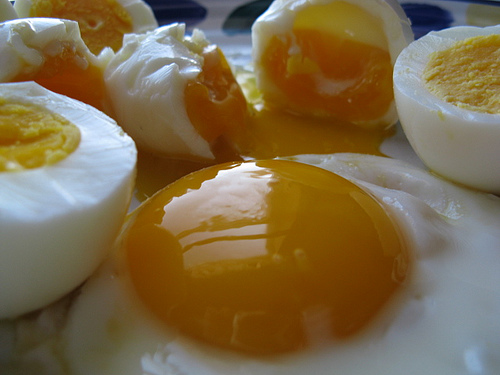
From the Healthhabits blog:
Need to lose a few pounds?
Try this…
Tomorrow morning, instead of wolfing down a bagel as you run out the door, scramble up a few eggs with some cheddar cheese and black forest ham.
According to a bunch of new studies, this high protein breakfast will help you manage your hunger while also reducing the amount of calories that you pack away throughout the day.
The Science
University of Conneticut researchers found that adult men who consumed eggs for breakfast:
- consumed fewer calories following the egg breakfast compared to the bagel breakfast
- consumed fewer total calories in the 24-hour period after the egg breakfast compared to the bagel breakfast
- reported feeling less hungry and more satisfied three hours after the egg breakfast compared to the bagel breakfast
This study was presented at Experimental Biology 2009. This research builds upon previous work by Dr. Fernandez which showed how the cholesterol from egg yolks improves the level of good (HDL) cholesterol.
.
A second study, published in the International Journal of Obesity, concluded that eating eggs for breakfast as part of a reduced-calorie diet helped overweight dieters lose 65 percent more weight and feel more energetic than dieters who ate a bagel breakfast of equal calories and volume.
And if that isn’t enough proof, you can check out this study which showed that getting your protein with breakfast was more effective at controlling hunger.
But what about the cholesterol?
For years, we have been told to avoid eating too many whole eggs.
We’ve been warned by the experts that the cholesterol found in those egg yolks are going to clog our arteries.
Maybe the experts are wrong.
New research (presented at Experimental Biology 2009) out of the University of Florida State examined the relationship between cardiovascular disease (CVD) risk factors such as body mass index, serum lipids and levels of high-sensitivity C-reactive protein (hs-CRP), and the degree to which these factors are influenced by dietary intake of fiber, fat and eggs. The study found:
- no relationship between egg consumption and serum lipid profiles, especially serum total cholesterol, as well as no relationship between egg consumption and hs-CRP
- a positive correlation between dietary trans-fat intake (the margarine on your bagel) and CVD risk factors, as well as a negative correlation between fiber and vitamin C intake and CVD risk factors(6)
In additional research presented at Experimental Biology, investigators with Exponent, Inc. evaluated egg consumption data from the NHANES III Follow-Up Survey to determine the association between egg consumption and heart health. The researchers developed a statistical model which showed:
- no increased risk of death from coronary heart disease with increased egg consumption
- a reduced risk of mortality among men who consumed one to six eggs/week compared to less than one egg/week
- a significant reduction in risk of stroke among women who consumed one to six eggs/week and one or more eggs/day
So, while I am not advocating that you chug back a dozen raw eggs at breakfast a la Rocky, I am suggesting that you replace your morning toast with an omelette.
Your shrinking love handles will thank you.


